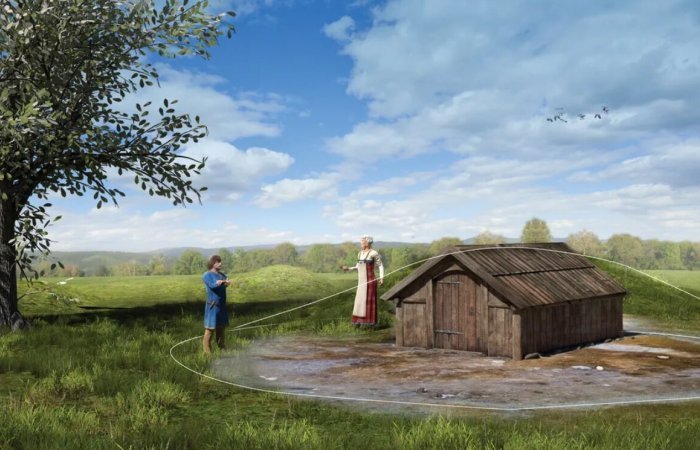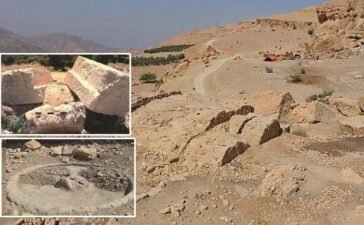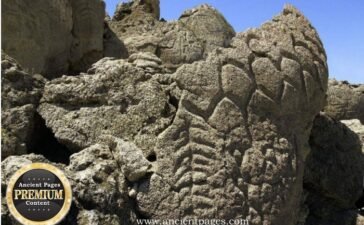Jan Bartek – AncientPages.com – Mortuary and funerary houses have been prevalent across various historical periods and geographical locations. These structures have been identified in diverse contexts, including Neolithic Northern Europe, Ancient Egypt, the Iron-Age Baltic region, and Viking-Age Scandinavia.
These house-like structures are typically found in funerary settings and serve multiple purposes. Some contain tombs and furnished graves, while others function as repositories for the remains of cremated or excarnated ancestors. Additionally, certain structures may have been utilized as shrines or places of worship and offerings associated with the deceased.
Location map with mentioned sites and places. By Raymond Sauvage, NTNU University Museum.
During the Nordic late Iron Age (AD 575/600–1050), particularly during the Viking Age (AD 800–1050), several mortuary features have been discovered that potentially represent similar structures. One notable example is the wooden chamber graves, which originated in 5th—to 8th-century Western Europe.
These wooden chamber graves later appeared in Scandinavia, with the most well-documented examples in Sweden and Denmark. Specifically, these structures have been discovered near the early towns of Birka and Hedeby, providing valuable insights into these ancient societies’ funerary practices and beliefs.
A recent publication in Medieval Archaeology by Dr. Raymond Sauvage and Dr. Richard Macphail details the excavation and analysis of three mortuary houses from the Iron Age and Viking Age in central Norway. These structures, located in Skeiet within the village of Vinjeøra, date from 500 A.D. to 950 A.D.
The mortuary houses are believed to have played a significant role in funerary practices, allowing the living to maintain ongoing interactions with the deceased. This discovery provides valuable insights into pre-Christian burial customs in the region.
The excavations, conducted between 2019 and 2020, were prompted by planned road construction. These archaeological efforts confirmed the presence of a pre-Christian cemetery, which had been partially investigated through a test pit in 1996. Notably, the excavations revealed flattened burial mounds and three previously unknown mortuary houses, adding a new dimension to our understanding of the site’s historical significance.
Aerial view overlooking the cemetery (foreground) during excavation in 2019 and the village of vinjeøra beyond, looking South-west. Photograph by Raymond Sauvage, © NTNU University Museum.
The mortuary houses discovered at Vinjeøra in Norway possess a distinctive characteristic. Unlike 12 other examples in Norway and one in Sweden, the Vinjeøra structures do not contain a permanent burial. This unique feature sets them apart from known mortuary houses in the region.
These structures offer valuable insights into past societies’ funerary practices and beliefs, particularly in Scandinavian contexts. The absence of permanent interments in the Vinjeøra mortuary houses raises intriguing questions about their specific function and the cultural practices they may represent.
“I think that the most surprising thing was that we did not find any evidence of a permanent tomb or a buried person inside the houses. Also, the fact that they had doors and entrances that may have led into the mortuary house and burial mound was something I had not thought of prior to the analysis,” says Dr. Sauvage.
The archaeological evidence indicates that mortuary houses were designed for permanent accessibility, as shown by the presence of doors and entrances. Compacted soil at the entryways supports the hypothesis of frequent visitation by the living. These access points were characterized by their low height, requiring a crouching posture for entry.
Dr. Sauvage explains that this architectural feature was common. The correlation between mound dimensions and house layout suggests a need for crouching. The interior chamber was likely compact and dimly lit, with the entrance providing limited illumination to certain areas. This configuration aligns with most mortuary houses in our records.
Chronological analysis reveals that the initial structure was built between 450 and 600 A.D., during the Iron Age, when cremation was the predominant funerary practice. The second structure was constructed around 600–800 A.D., coinciding with a transitional period towards increased inhumation. The third mortuary house was established between 800 A.D. and the mid to late 900 A.D., after the complete shift from cremation to inhumation as the primary burial method.
Each structure remained functional for approximately 100–200 years, indicating that despite evolving burial customs, mortuary houses retained their significance in funerary rituals.
“It seems to me that the burial practices seem to have been affected by a number of factors, such as influences from travel and contact and changing motivation behind what to amplify in the more public displays seen in burial rituals.
“The mortuary houses show a more stable continuity in use, probably related to the families’ own tradition of venerating their deceased and ancestors. These rituals could have been more private and may have been more stable over time,” Dr. Sauvage says.
Despite the lack of burials, artifacts found in mortuary houses, including bone fragments, projectile points, and iron fasteners, may reveal their purpose. Horse remains suggest possible sacrificial practices like blót, a Norse ritual often linked to funeral feasts. While direct evidence of sacrifice is absent, other burned animals remain hints of ritual meals. This may reflect the Norwegian tradition of leaving food and drink at burial mounds for the deceased.
Artist’s interpretation of one of the Skeiet mortuary houses. The burial mound is indicated by the conjectured lines. Credit: Sauvage and Macphail 2024; illustration by Arkikon, NTNU University Museum
The houses’ resemblance to dwellings might indicate a belief in the dead inhabiting burial mounds. Alternatively, these structures may have temporarily housed bodies during funeral preparations, aligning with Ibn Fadlan’s 10th-century account of Norse burial rituals. The function of Norway’s mortuary houses remains unclear, requiring further research.
Dr. Sauvage underscores the importance of directing future research efforts towards the interior aspects to obtain more comprehensive data regarding their utilization. The current evidence at our disposal is fragmentary, and numerous inquiries remain unresolved, including the interior’s appearance, the potential existence of a designated area for corpse placement, and the configuration of the entrances.
We must better understand their relationship to burial mounds. We need to determine if stratigraphic evidence can prove these structures were covered by the mound or if the mound was added later.
“The study suggests that these entrances served as doors and portals into burial mounds, which functioned as a threshold between the world of the living and the world of the dead, that may have facilitated ritual communication with deceased close kin and ancestors.,” the researchers write in their study.
The study was published in the journal Medieval Archaeology
Written by Jan Bartek – AncientPages.com Staff Writer









